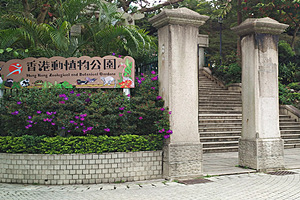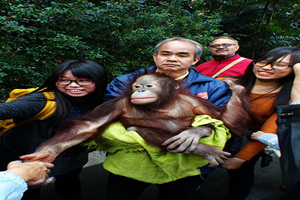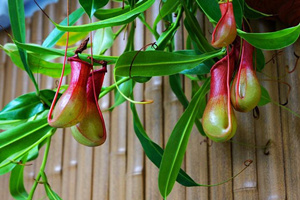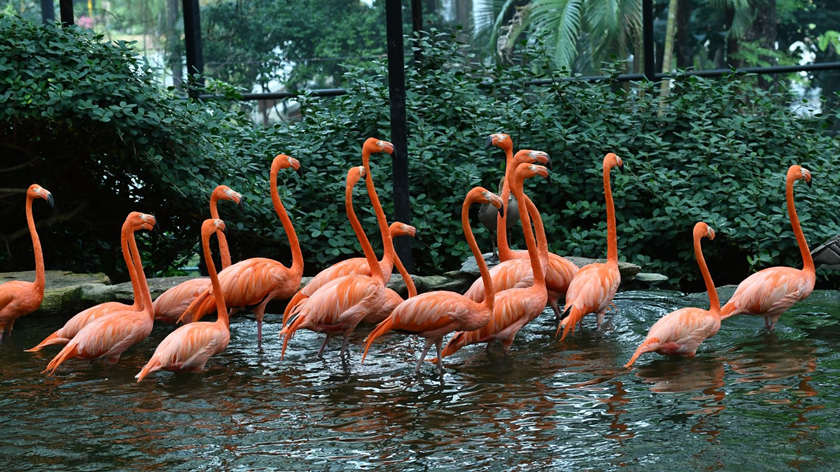Chinese Name: 香港动植物公园 Pronunciation: xiāng gǎng dòng zhí wù gōng yuán
Suggested Visiting Hours: 1-2 Hours
Admission Ticket Fare: Free
Park Area: About 5.6 hectares
Building Time: 1871
Best Visiting Time: All year round
Address: Abentley Road, Central district, Hong Kong
|
Attractions
|
Opening Hours
|
|
| Fountain Terrace Garden | 5:00 ~ 22:00 | |
| Greenhouse / Education and Exhibition Center | 9:00 ~ 16:30 | |
| Other Areas | 6:00 ~ 19:00 | |

The Hong Kong Zoological and Botanical Gardens, originally known as the Botanical Park, was the earliest park established in Hong Kong. It was once used as the Governor's residence. In the early days, it was also called the "Bing Tau Fa Yuen" (“Bing Tau” means the head of soldiers and “Fa Yuen” means garden) because the Governor often served as the commander of the armed forces. It is located at the Abentley Road, Central district of Hong Kong Island, and covers an area of 5.6 hectares.
The Hong Kong Zoological and Botanical Park is the largest plant and bird park in Hong Kong. It was fully completed and opened to the public in 1871. It has the largest greenhouse in Southeast Asia, exhibiting more than 2,000 kinds of rare plants. Besides, more than 100 wild birds are raised here, including some endangered species. There is also a cast-iron music platform in the Hong Kong Zoological and Botanical Gardens, which is an excellent place for people to visit.

Between 1841 and 1842, the site of the Hong Kong Zoological and Botanical Garden was once the residence of the Governor of Hong Kong.
The Hong Kong Zoological and Botanical Gardens was first built in 1860.
In 1871, the park was fully opened to the public and officially named as "Hong Kong Botanic Park".
Since 1876, birds and mammals have been kept in the park for tourists to visit.
In 1970s, the park expanded the second phase of the Hong Kong Zoological and Botanical Park on Albany Road and brought in many mammals and reptiles.
In 1975, it was officially renamed as the Hong Kong Zoological and Botanical Gardens, and the park also began to change from simply raising animals for the purpose of display to studying animal breeding techniques, and has successfully bred a variety of primates.

There are more than 900 kinds of plants in the park, most of which are produced in tropical and subtropical regions, including the Conifer, Fig, Gum Trees, Palm, Magnolia, Azalea, Camellia, Philodendron as well as the native flora.
The local Ailanthus, the Dawn Red-wood, Crapnell's Camellia, Grantham's Camellia and Yellow Camellia are rare. The Norfolk Island Pine, Travellers-tree, Asoka Tree, Royal Palm, Forest Grey Gum and the Elephant Apple have distinctive features in form, leaf-shape, bark and fruit. The Garden is often filled with the fragrance of roses, Mock Lime, Orange-jessamine, Kwai-fah, Chinese Privet and the White Jade Orchid Tree. You can smell it when you walk in the garden. Some conspicuous flowers bloom all the year round such as Hong Kong Orchid Tree, Coral Tree, Camel's Foot Tree, Wormia, Stiff Bottle-brush, Spider Tree, Candlenut Tree and Kassod Tree. Visitors can see all these trees identified with labels as they walk along the paths.
In the south of the park there is a herb garden, and shrubs can be found in the fountain platform garden, where colorful flowers are also planted.
More than 150 species of native and exotic plants, including orchids, ferns, pineapples, climbers and houseplants, etc., are planted in the greenhouses on the east side of the park.

The history of keeping wild animals for exhibition in the Hong Kong Zoological and Botanical Gardens can date back to 1876. At that time, some birds and mammals were raised in the primitive buildings in the park purely for visitors' enjoyment.
After a large-scale expansion in the mid-1970s, the park shifted its focus to breeding techniques. Today, the park still lays an emphasis on this direction, promoting various activities within the park. It promotes the public's awareness and attention to various living things through education, conservation, research plans and exhibitions, and it leads the public to appreciate the way that species coexist with nature.

Green house refers to a building that can control or partially control the growth environment of plants. It is mainly used for non-seasonal or non-regional plant cultivation, scientific research, additive breeding and ornamental plant cultivation, etc. The green house is one of the indoor facilities of the Hong Kong Zoological and Botanical Gardens. Its theme exhibits are divided into six categories, namely: orchids, ferns, climbers, bromeliads, carnivorous plants, scented plants and variations of plants.
Among them, orchids are the largest family and genus in the plant kingdom. So far, more than 700 genera and 25,000 species have been discovered. There are about 120 native orchid species in Hong Kong. Fern is a primitive plant that grows in a humid or dark environment. About 19,000 species have been discovered so far. Hong Kong is rich in ferns, and there are currently about 214 species here. Climbers refer to those plants that rely on other plants supporting climbing upwards. There are currently about 300 species of climbing plants in Hong Kong. When it comes to carnivorous plants, in addition to using sunlight to produce nutrients through photosynthesis, carnivorous plants also prey on insects or other small animals to supplement nutrients. This kind of plants will attract prey with bright colors or scents, then stick them with sticky leaves, or drown them with sap, and finally these plants will secrete digestive juice to dissolve them.
If you want to know more about these plants, please go to visit the Green House of Hong Kong Zoological and Botanical Gardens!
If you go to Hong Kong Zoological and Botanical Gardens, you can take bus 12, 12A, 12M, 13, 23, 23B, 40, 40M, 103 or minibus 1A, 22, 22S, 28.
Chinese: 请带我去香港动植物公园。English: Please take me to the Hong Kong Zoological and Botanical Gardens.
If you go to the Hong Kong Zoological and Botanical Gardens from the Causeway Bay, it takes about 12 minutes and costs about 293 yuan.
If you go to the Hong Kong Zoological and Botanical Gardens from the North Point, it takes about 19 minutes and costs about 293 yuan.
If you go to the Hong Kong Zoological and Botanical Gardens from the Lok Fu Building, it takes about 19 minutes and costs about 349 yuan.
If you go to the Hong Kong Zoological and Botanical Gardens from the Admiralty, it takes about 6 minutes and costs about 293 yuan.
If you go to the Hong Kong Zoological and Botanical Gardens from the Central, it takes about 16 minutes (293 yuan).
